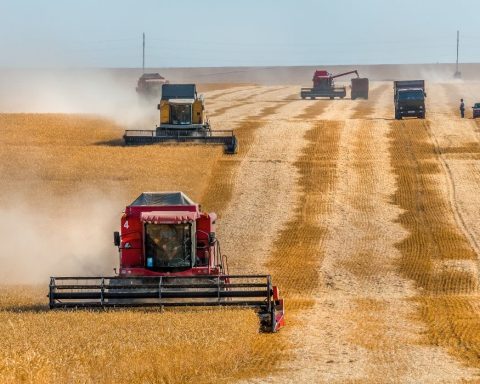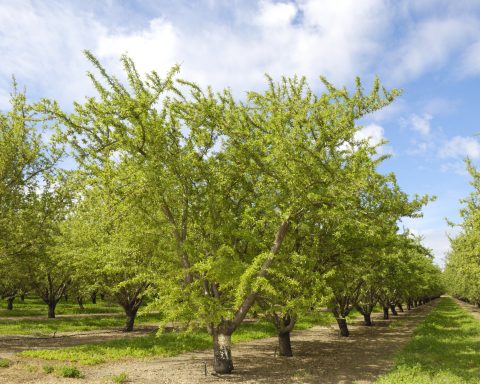Over the last half century, industrial agriculture has evolved to grow as much low-cost food as possible, with the promise of feeding the world’s hungry. Between 1960 and 2015, the amount of food produced across the world more than tripled. But these massive yields have come at a heavy environmental and ecological cost.
In Canada, the agricultural sector accounted for roughly 10% of our greenhouse gas emissions in 2019. These emissions have steadily increased since 1990 thanks to yield-boosting petrochemical fertilizers and livestock farming – emissions that will need to come down fast if the sector is going to do its fair share in helping Canada meet its climate targets, said Ralph Torrie, head of research at Corporate Knights, at part five of our Earth Index series tackling the “say–do” gap in Canada’s high-emitting industries.
But in the last year, the rate of emissions reductions in Canada’s agricultural sector was a mere 14% of what it needs to be to hit our 2030 targets.
“We have little to show in terms of emissions reduction progress from this sector, which leaves a large ‘say–do’ gap,” Torrie told the panel February 2.
Carbon sink
In recent years, the National Farmers Union has been taking a fine-grain look at where Canada’s agriculture emissions are coming from. For the last century, we’ve done something unprecedented: “We’ve created a very high-input, high-emission food system,” said Darrin Qualman, the director of climate crisis policy and action at National Farmers Union (Canada). Qualman said government policies have only made matters worse: “In Canada, the core directive is to maximize exports. This leads to a production maximization policy and, unfortunately, an input maximization policy, and the unintended consequence is we’re also maximizing the emissions coming out.”
There are signs that’s beginning to shift. Last year, the federal government said it would spend $200 million over two years to help farmers keep more carbon in the ground. Part of these funds will go towards helping farmers reduce the amount of synthetic nitrogen fertilizers they use. Nitrogen fertilizers emit nitrous oxide – a potent greenhouse gas that is 300 times more damaging to the climate than carbon dioxide. The government has also said it would pay farmers to grow cover crops (which are grown between seasons to improve soil health) and use rotational grazing practices.
We have little to show in terms of emissions reduction progress from this sector, which leaves a large ‘say–do’ gap.
-Ralph Torrie, head of research at Corporate Knights
While “regenerative agriculture” is a buzzword being adopted by politicians and food companies, the ideas behind them are deeply rooted in Indigenous farming methods that go back generations. Terrylynn Brant, the founder of Mohawk Seedkeeper Gardens, told the panel that Indigenous people, who have farmed sustainably for millennia, often don’t get credit for having invented these practices.
Brant, who is a seedkeeper, said her community in Ohsweken, Ontario, plants crops like corn with just a stick with no need for tilling, and uses companion planting – growing crops together that are mutually beneficial – to limit pests. Her community eats seasonally, thinks of food as “life’s sustainer,” and considers its agriculture “Earth healing.”
“If you’re destroying the Earth, you’re not a farmer as far as our people are concerned,” she said. “You’re a killer.”
Mouths to feed
Some have questioned whether regenerative agriculture can be scaled to the level needed to feed the world’s growing population and claim that input-intensive industrial farming is necessary to make sure people don’t starve. But Gillian Flies, an organic vegetable farmer from Creemore, Ontario, and the president of Canadian Organic Growers, told panellists such arguments are a scare tactic by conventional agriculture. “It’s currently not working,” she said of today’s food landscape.
Flies, who also co-founded the Farmers for Climate Solutions coalition, said that there is plenty of food but that a lot of it is processed (making poor use of higher-yield products, as Qualman noted), and that regenerative practices can bring old farmland, that has been desertified by industrial agriculture, back into production.
While regenerative agriculture has attracted a lot of attention for its potential to lock carbon into the soil, the science on just how much carbon it can sequester in the ground is unsettled. Nature’s Path Foods has been piloting the use of Regenerative Organic Certified ingredients in some of its products, though the company’s organic program manager, Dag Falck, told the panel the benefits last only as long as farmers maintain the practices that support the very microbial organisms in soil that draw down carbon. “When we talk about locking carbon in the soil, we’re not locking into the soil forever – only as long as there are healthy organisms in the soil.”
If you’re destroying the Earth, you’re not a farmer as far as our people are concerned. You’re a killer.
-Terrylynn Brant, founder of Mohawk Seedkeeper Gardens
Data is now coming in to support the shift to low-carbon agriculture, said Gary Csöff, a senior digital agribusiness consultant with IBM. “Data is kind of the new commodity on a lot of farms,” he told the panel. But he said that while momentum is building in support of climate action on farms, there is no silver bullet. “It’s not going to be ‘let’s turn a light switch on’ and all of a sudden we lose a bunch of emissions.”
One key way Canada can bring down emissions in the sector is by moving away from greenhouse-gas intensive livestock agriculture. Innovative cell-based cultured proteins and plant-based alternatives will be central to that effort. Adam Noble, the CEO of biotech start-up Noblegen, is making proteins using a microorganism called Euglena gracilis. “With the world primarily relying on animal sources as our protein source … we can’t afford to do that at the scale we’re going at,” he said.
Scaling up solutions will require greater government support, noted Flies, pointing out that on a per acre basis Canada invests 73 times less than the EU and 13 times less than the United States on climate-friendly agriculture practices. “We aren’t going to get anywhere quickly without changing policy.”





